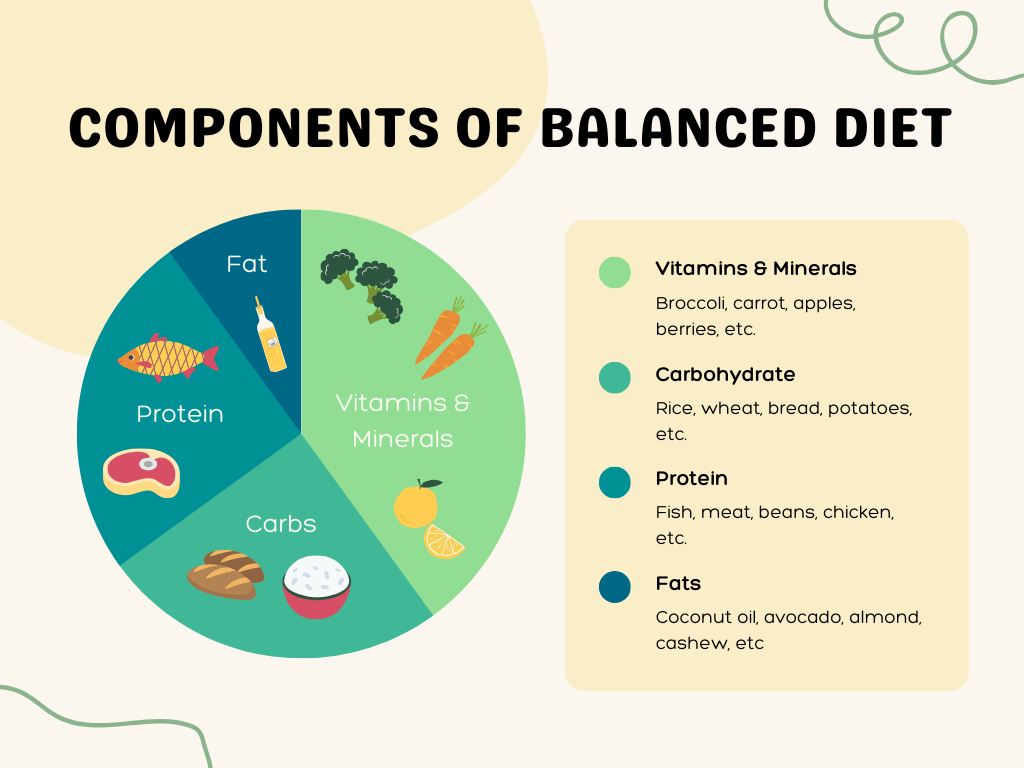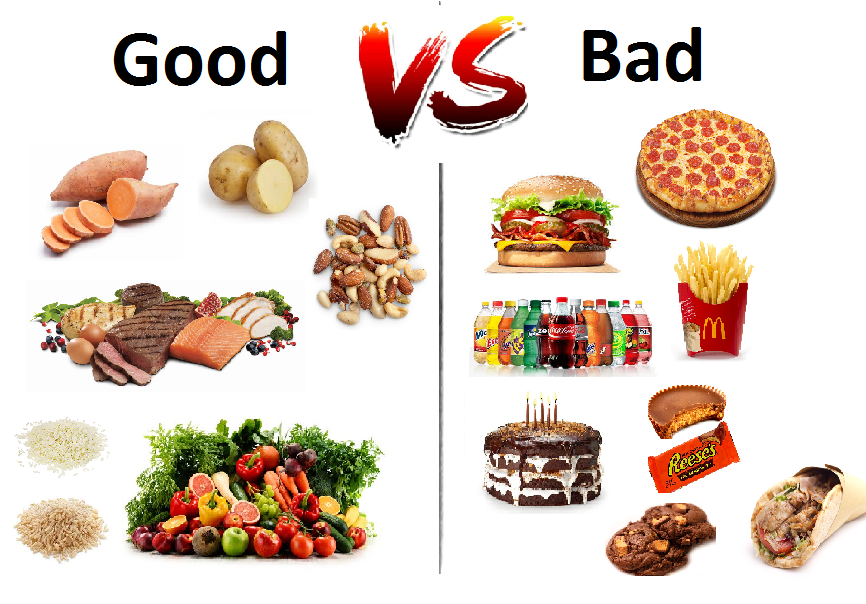Another fundamental requirement for a healthy life and the creation of a healthy body is healthful eating. Among all the continuously changing diet trends that have been around today, one thing that remains very significant in the nutritional table is a balanced diet. But what is meant by a balanced diet and what does it for you? Here in this blog, you will get to learn the basics of a Balanced Diet, its benefits, and how to make it work for you.
What is a Balanced Diet?
An eating plan outlines the types and amounts of food needed to provide essential nutrients, including carbohydrates, proteins, fats, vitamins, and minerals for normal body functioning.
Components of a Balanced Diet:
1. Carbohydrates: Supply energy and are present in grains, fruits, vegetables, and many other types of foods.
2. Proteins: Mandatory for growth and regeneration, it is mostly obtained from meats, beans, nuts, and dairy produce.

3. Fats: Essential for energy and hence cell functions, the healthy fat is gotten from sources such as avocados, nuts, and olive oils among others.
4. Vitamins and Minerals: Play a role in the support of the body’s activities and are present in fruits, vegetables, dairy products, and meat.
5. Water: Water is required by the body, to serve diverse purposes which include the most basic one which is the hydration of the body.
To understand the Factors Affecting Human Health it is important to learn the benefits of a Balanced Diet
1. Improved Energy Levels
An energy-giving diet involves eating balanced meals that supply the body with energy at regular intervals. Carbohydrates serve as the body’s preferred energy source, while proteins and fats also provide energy. Consuming a variety of nutrient-packed foods keeps the body active and alert.
2. Enhanced Digestive Health
A diet that outlines the servings of fruits, vegetables, and whole grains is good for the body since they contain the necessary fibers for digestion. Fiber reduces the rate of constipation, assists in the defined movement of bowels, and supports a healthy content of the gut thus an aspect of digestion.
3. Stronger Immune System
Vitamins and minerals have the essential function of serving as the immunological guard of any person’s immune system. Many of the vitamins and minerals such as vitamins C and D, zinc, and antioxidants coupled with the help of the human immune system work to ward off infections and diseases. Proper nutrition, including fruits, vegetables, lean proteins, and fats, nourishes immunity and keeps you out of the hospital.
4. Healthy Weight Management
A balanced diet sustains your body in terms of necessary nutrients without excess calories that may lead to an increase in weight. Protein contents provide satiating qualities to the body coupled with the fact that taking many small portions of nutrient-dense foods aids in preventing the excess intake of food. Together with physical activity, a proper diet helps in controlling the weight of the individual.
5. Better Mental Health
It is a known fact that nutritional food that is taken has a way of influencing the mental health of an individual. Analgesic: Omega-3 fatty acids which are expressed in fish and flaxseeds are known to have an impact on the health of the brain and decrease signs of depression. Major vitamins and minerals also have an impact on the moods and manner in which the brain works.
6. Improved Heart Health
These diseases are an outcome of a diet that lacks fruits, vegetables, whole grains, and other healthy fats, necessary for proper functioning of the heart. There is an important constituent of the diet that is necessary in the management of cholesterol, blood pressure, and arterial health; and these include oats, nuts, and fatty fish.
7. Stronger Bones and Teeth
There are some nutrients, for instance, calcium, vitamin D, and phosphate that are vital in the body mainly because they contribute to the formation of bones and teeth. Calcium and iron are obtained from products such as dairy products, greens, and other foods that are enriched with these nutrients to avoid ailments such as osteoporosis and dental caries.
8. A note on skin, Hair, and nails.
Negative calorie foods help nourish skin, hair, and nails as well as help build strong bones and muscles making a balanced diet very important. Vitamin antioxidants which include vitamins A, C, and E as well as omega-3 fatty acids are all vital in skin and hair development. Supplementation with water found in drinking water also benefits the skin in a way.
9. Regulated Blood Sugar Levels
Carbohydrates, proteins, and fats should be taken in appropriate proportions to check fluctuations in blood sugar. Low GI foods, from which more glucose is released, include whole grain foods and pulses, lowering the risk of insulin resistance and diabetes.
10. Improved Sleep Quality
Some nutrients, therefore, have an impact on the quality of sleep. Muscles are relaxed by Magnesium and it also helps have a good sleep, which can be obtained from nuts and green, leafy vegetables. These nutrients can help to enhance sleep patterns and the general health of a person, given that a healthy proportion of these nutrients is consumed.
Harmful and Helpful Foods
To capture the dividends associated with the cultivation of a balanced diet, ensure a regular intake of many meals that are rich in nutrients. Here are some guidelines and examples of what to eat: Here are some guidelines and examples of what to eat:

1. Fruits and Vegetables
Aim for Variety: Eating crisp and radiant vegetables and fruits ensures that one takes many vitamins and the body gets many minerals also. Some recommended vegetables to include are berries, dark-colored green leafy vegetables, bell peppers, and sweet potatoes.
Portion Size: Ideally, make an effort to always place at least half of your food on the plate to be vegetables and fruits.
2. Whole Grains
Choose Whole Over Refined: Choose foods prepared with whole grains such as brown rice, quinoa, whole wheat bread, and stout. Again, whole, grains supply the body with more fiber, vitamins, and minerals as compared to refined grains.
3. Lean Proteins
Include a Variety: Lean proteins should form part of the diet and these include; chicken, turkey, fish, beans, lentils, and tofu. These are used in muscle repair and building as they are fundamental amino acids.
4. Healthy Fats
Opt for Unsaturated Fats: Include sources of healthy fats including avocados, nuts, seeds, and olive oil. These fats are good for the heart and contain important fats also known as essential fatty acids.
5. Dairy or Dairy Alternatives
Opt for low-fat or fat-free dairy options like milk, yogurt, and cheese. For those who are lactose intolerant, plant-based alternatives such as almond, soy, or oat milk are great choices, often fortified with calcium and Vitamin D for added nutritional benefits.
Incorporate Calcium-Rich Foods: Ensure that you take a diet of foods that contain calcium like fortified soy milk and spinach.
6. Hydration
Drink Plenty of Water: The quantity of water one should take per day should be at least eight glasses of water. Drinking water also allows the body to respond properly to different activities as well as carry out various essential functions.
Hints to Following a Balanced Diet
1. Plan Your Meals
Create a weekly menu: Prepare ahead to ensure you include nutrient-dense foods in your meals by observing proper food combinations. Planning your meals helps you maintain a healthy diet instead of grabbing the nearest unhealthy option.
2. Practice Portion Control
Be Mindful of Serving Sizes: Adverse control your portions because eating beyond your required limit is unhealthy for your body. Other strategies like using small plates and bowls can also assist a lot in moderation and reduced portion sizes.
3. Incorporate Healthy Snacks
Choose Nutritious Options: It is good to have healthy snacks in the house for instance fruits, nuts, yogurt, and whole grain crackers. These are useful in avoiding feelings of hunger between meals, thus avoiding taking unhealthy snacks.
4. Cook at Home
Prepare Meals from Scratch: When you prepare meals at home, you have the option to choose what to use in the preparation and also decide the amounts issued, thus it is easier to eat healthily.
5. Stay Flexible
Enjoy Treats in Moderation: Still, one should indulge in such options from time to time and try to make a healthy choice when it comes to snacks. Fifty/fifty rule means that it is possible to consume a proper quantity of food without forcing the body to lose weight.
6. Listen to Your Body
Pay attention to hunger cues: Follow the hunger/fullness rule, also known as the eat-stop-eat rule. Eat when you feel hungry and stop when you’re full. Understanding your body’s signals can help you maintain a healthy diet.
7. Seek Professional Guidance
Consult a Registered Dietitian: If you have certain special requirements concerning your food selection or some health issues, it is best to speak with a registered dietitian. They can offer advice and assist in drawing up a diet plan that would incorporate all necessary nutrients into the meals required by the consumer.
Conclusion
A well-balanced diet is crucial for a fulfilling life and overall health. By including a variety of nutrient-rich foods and following moderation guidelines, you can fully experience the positive effects of good nutrition.
A balanced diet promotes physical well-being, enhancing energy levels, gut health, brain function, and heart health, ultimately leading to a better life. Focus on the principles of a balanced meal to establish a healthy diet and stimulate your mind, paving the way for a happy and healthy lifestyle.
Must Read: The Science of Intermittent Fasting: Benefits and Tips



